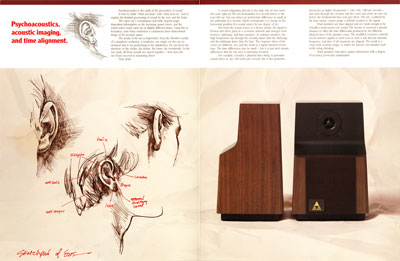Psychoacoustics, acoustic imaging, and time alignment.
Psychoacoustics is the study of the perception of sound.
It tries to relate "what you hear" with "what went in," and to explain the detailed processing of sound by the ears and the brain.
The outer ear's convolutions and folds imprint angle-dependent information on the incoming sound waves, and the sound waves reach each ear at slightly different times. Using this information, your brain constructs a continuous three-dimensional image of the acoustic space.
The acuity of the ear is impressive: from the blended sounds of a symphony orchestra, a conductor can single out the one instrument that is not performing to his satisfaction. He can focus his attention on the violins, the drums, the brass, the woodwinds. In the ear canal, all these sounds are mixed together - how does the
ear /brain succeed in separating them?
Time delay.
A sound originating directly to the right side of your head hits your right ear five ten-thousandths of a second before it hits your left ear. You can detect an arrival-time difference as small as ten millionths of a second, which corresponds to a change in the horizontal position of a sound source by one degree of arc.
But when the sound source is a stereo system, the signal is broken into three parts in a crossover network and emerges from tweeters, midrange, and bass speakers. In ordinary speakers, the high frequencies zip through the circuitry faster than the midrange, and the midrange faster than the bass. The response times of the cones are different, too, and the result is a signal smeared across time. The time differences may be small - but it is just such minute differences that the ear uses to determine location.
For example, consider a plucked bass string. It generates sound waves at, say, 160 cycles per second. But it also generates
harmonics at higher frequencies - 320, 640, 1280 per second - that dash through the circuitry and the cones and arrive at your ear before the fundamental bass note gets there. The ear, confused by the time smear, cannot assign a definite location to the signal.
Triad speakers are time aligned and are small enough to be virtually a point -source for sound. The tweeter is recessed a precise distance to offset the time differential produced by the different physical sizes of the speaker cones. The modified crossover network circuit delivers signals to each cone in such a way that the intensity, frequency, and time of all transients are aligned. The result is a crisp clear acoustic image, in which the listener can visualize each violin string vibrating.
Triad speakers reproduce spatial information with a degree of accuracy previously unattainable. |
